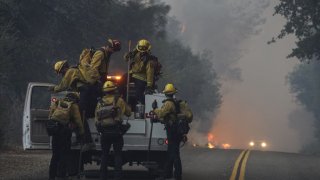
Fire crews from across the state were being deployed to Northern California, where hot, windy conditions Wednesday renewed fire threats in the region where massive blazes already have destroyed hundreds of homes and killed or injured dozens of people this year.
Most of the huge fires that erupted over the past eight weeks are now fully or significantly contained and skies once stained orange by heavy smoke are blue again. Containment means that firefighters have lines holding in a fire, though it doesn’t mean a fire has stopped burning.
But the gains made by thousands of firefighters assigned to the blazes that have scorched more than 4.1 million acres this year could be hampered if new fires ignite, said Daniel Berlant, assistant deputy director with the California Department of Forestry and Fire Protection, known as Cal Fire.
“If a new fire breaks out, that fire will be able to grow very quickly under these conditions,” Berlant said.
The National Weather Service issued a red-flag warning for extreme fire danger from 5 a.m. through Friday morning. With bone-dry humidity and wind gusts possibly hitting 55 mph, Pacific Gas & Electric, the largest utility in the nation, warned that it may cut power starting Wednesday evening to as many as 54,000 customers in 24 counties.
Preemptive electricity cuts are a strategy aimed at preventing fires from being started by power lines that have been damaged or knocked down amid high winds. PG&E equipment sparked several massive blazes that destroyed tens of thousands of homes and killed more than 100 people since 2017.
“We really view it as a last resort option,” said Mark Quinlan, the company’s incident commander.
California
The utility also has deployed generators and other measures to keep electricity flowing in some areas that might loose power during the outages, Quinlan said.
About 33,000 homes and businesses could begin losing power at 6 p.m., mainly in the Sierra Nevada foothills and northern San Francisco Bay Area, followed by 21,000 other customers two hours later in other portions of the Sierra and the Bay Area, along with portions of California’s central coast, PG&E said.
The figures for affected customers range from more than 11,300 in Butte County, 6,000 in Santa Cruz County and around 5,400 customers in Alameda County, according to the utility.
Denise Bethune lost her home of 12 years last month after a blaze razed her tiny foothills community of Berry Creek, about 160 miles (260 kilometers) northeast of San Francisco in rural Butte County. The night before, PG&E cut off power and she and her husband couldn’t use their well to get water and hose down their home.
Bethune, who has multiple sclerosis, said cutting power is a double-edged sword because it can help prevent fires from starting but it causes other issues.
“Whenever there is a power outage, my main concern is the heat because I can’t handle it without air conditioning due to my medical needs,” she said.
Since being displaced, Bethune, her husband and three dogs have been living in a trailer they parked on her son’s orchard near the city of Chico that has its own power source.
All power should be restored by late Friday night, the utility said.
The outages would include regions already hit by massive wildfires this year and in recent years. The Glass Fire that ravaged the Northern California wine country of Napa and Sonoma counties was surrounded Wednesday after destroying more than 1,500 homes and other buildings.
PG&E said it could cut power to more than 9,200 customers in Napa and around 1,800 in Sonoma.
Farther north, the Zogg Fire in Shasta and Tehama counties was 99% contained. Four people died in that blaze. PG&E said nearly 6,000 customers could lose power in Shasta and Tehama counties.
More than 8,500 wildfires have burned more than 6,400 square miles (16,000 square kilometers) in California since the start of the year, most since mid-August. Thirty-one people have died, and more than 9,200 buildings have been destroyed.
Numerous studies have linked bigger wildfires in America to climate change from the burning of coal, oil and gas. Scientists have said climate change has made California much drier, meaning trees and other plants are more flammable.
PG&E said last month that it is using smarter and shorter power shutoffs after receiving widespread criticism from the public and regulators last year when it turned off electricity to 2 million people to prevent its equipment from sparking wildfires.
PG&E’s aging equipment sparked the deadly 2018 fire that destroyed much of the town of Paradise and killed 85 people.
The utility pleaded guilty in June to 84 felony counts of involuntary manslaughter — one death was ruled a suicide — and paid $25.5 billion in settlements to cover the losses from that and other recent power line-sparked catastrophes.



